Previously on Baxter Building: For once, the What Has Come Before of it all is pretty important for these issues, so here’s what you really need to know: The Thing left the Fantastic Four at the end of Secret Wars to stay in space, and in his absence, his girlfriend Alicia ended up getting together with — and eventually marrying — his former teammate the Human Torch. When he eventually came back to Earth, he went through an unconvincing tough guy phase, but just when you think he’s gotten to some kind of emotional catharsis… Steve Englehart shows up to make things really uncomfortable for everyone involved.

0:00:00-0:15:20: We open things up, somewhat unexpectedly, with a summation of the issues to come. Chalk it up to my excitement over the arrival of Steve Englehart as series writer, and the soap operatics he brings with him. But are those soap operatics too much? Jeff and I spoil some of the plot elements lying ahead as we discuss Jeff’s misgivings over where Englehart goes, and more importantly, how far he goes with some of the dysfunctional pieces of his Fantastic Four, before jumping straight into…
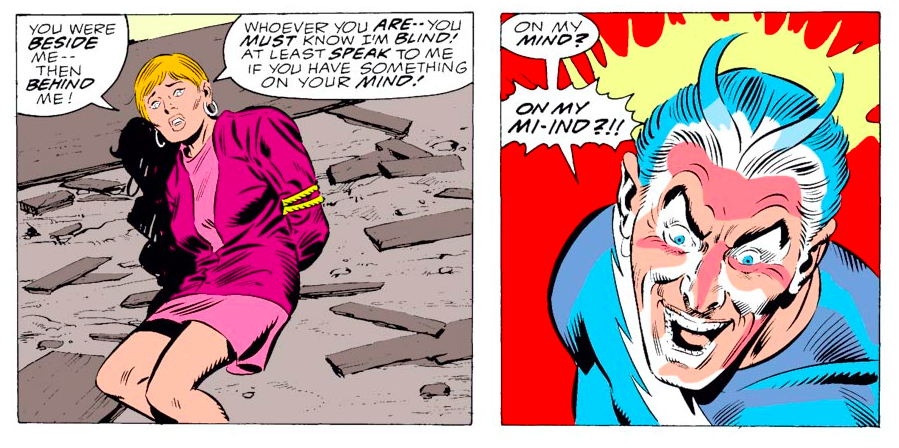
0:15:21-0:31:43: …Fantastic Four #304, in which Quicksilver arrives as a villain and also an analog for the Thing, although that is curiously underplayed in an issue where almost nothing is underplayed. Plus, the FF rejoins the Marvel Universe, the way the Englehart era is already different from the Byrne era, Englehart’s work co-existing with the Englehart legacy as the Marvel Universe, and the best Roy Thomas impression you’ve ever heard.
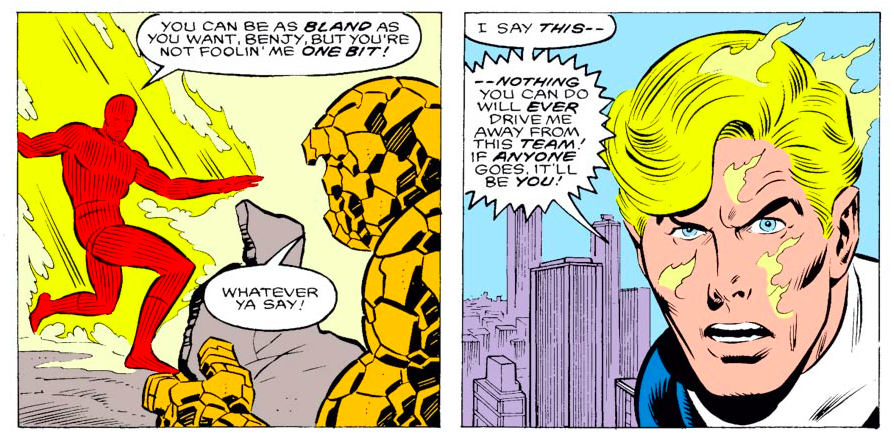
0:31:44-0:42:40: Is Ben Grimm more of a monster than we’re willing to admit? FF #305 makes a good case that the answer is yes, but it’s not because he’s made of orange rocks. Jeff and I talk about Ben’s bad decisions, the emotional complications that feel at once soap operatic and honestly complex, and the ways in which the series continues to shift with each issue while still feeling utterly organic.
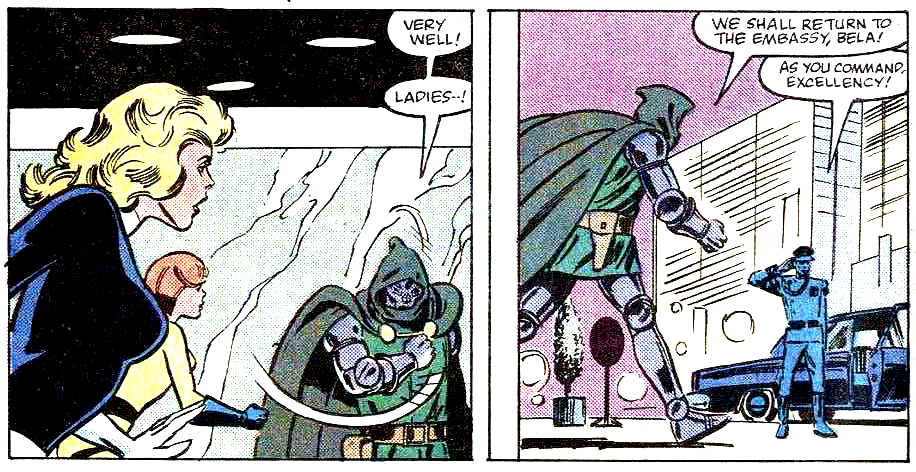
0:42:41-0:54:25: It’s the surprise Fantastic Four Annual #20 that I didn’t know we were going to be covering this time around — but that turns out to be a very happy accident, as we get two times the Doctor Doom (and both Jeff and I love Englehart’s Doctor Doom) and the best Reed Richards we’ve probably seen during the entire run of the series. All this, and at least two bits of story that are just so good that we couldn’t help but comment on them (as well as the answer to the question, “Why should you always take the first deal Doctor Doom offers?”) — face it, friends: this might be the Mighty Marvel Age of “Guess That Was A Good Thing We Had An Annual To Read, After All!”
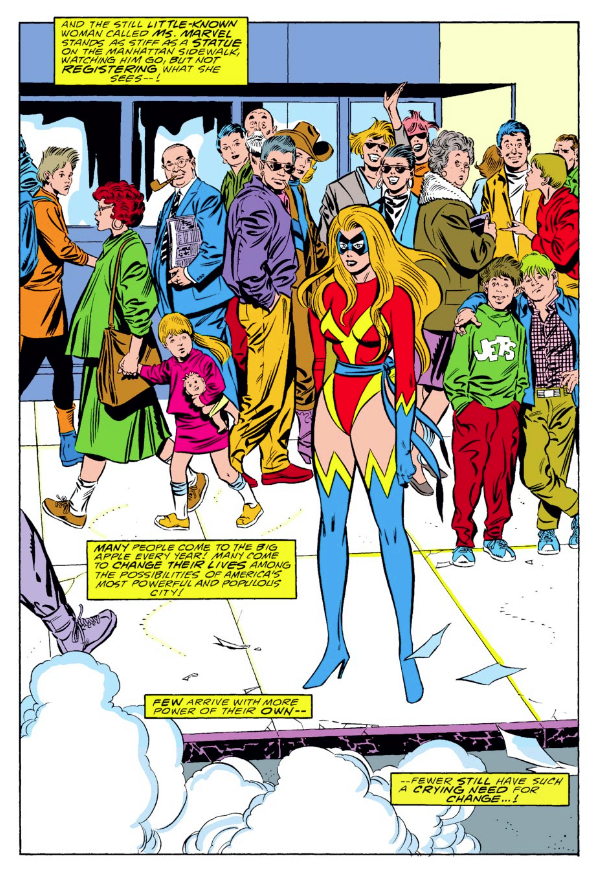
0:54:26-1:22:29: The arrival of Sharon Ventura in FF #306 brings with it discussions of both John Buscema’s appreciation of the opportunity to show regular folks on the street in New York City, and our discomfort with Sharon’s backstory and how fucked up it is that “gang rape as character motivation” managed to actually make it into print, especially during the period where comics were still ostensibly being at least partially targeted at kids. As Jeff puts it, “Steve Englehart, please!” There’s also brief discussion about a never-followed-up-on direction for the Inhumans, and whether or not the book has slipped out of the definition of what you expect from Fantastic Four as a series.
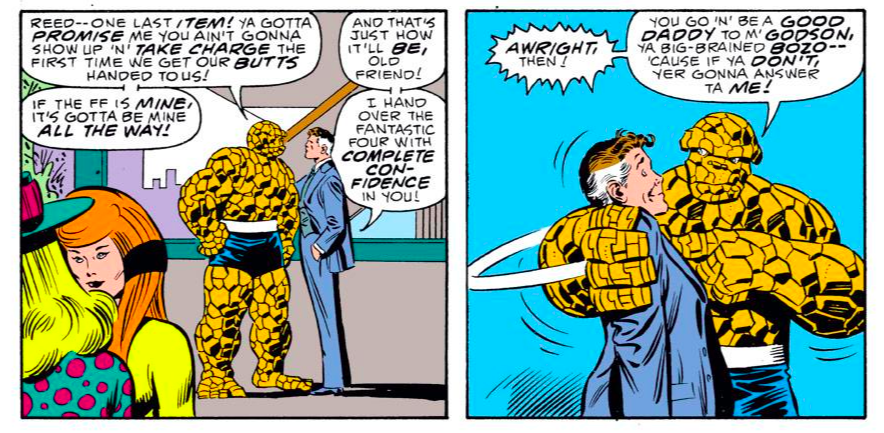
1:22:30-1:34:20: The highpoint of Fantastic Four #307? That would be John Buscema and Joe Sinnott’s artwork, which we both define as an amazing swan song for the team on the book, which is embarrassing because they stay on the book for another couple of issues. But you know who is leaving? Reed, Sue and Franklin who leave the book forever with this issue! (Note: It’s not as forever as people believed at the time.) Meantime, Diablo displays all-new powers, and Jeff overshares about his personal hygiene. But, really, it’s all about the Buscema/Sinnott artwork. Here’s the Franklin panel Jeff was talking about:

1:34:21-1:53:47: FF #308 introduces the racist character find of 1987, Fasaud! But if the mix of Max Headroom and fear of Arabic nations isn’t enough, there’s also a nice moment of confusion on behalf of the Fantastic Four, a moment of betrayal for the Human Torch — even if Jeff and I manage to almost forget to explain what that’s actually about — and a discussion about whether or not Fasaud is Kirbyish in the strangest manner imaginable (and perhaps the 1980s Doctor Doom, in Jeff’s mind). And even more creepiness between Ben and Sharon, and I remind everyone just how creepy Steve Englehart’s Green Lantern Corps run.
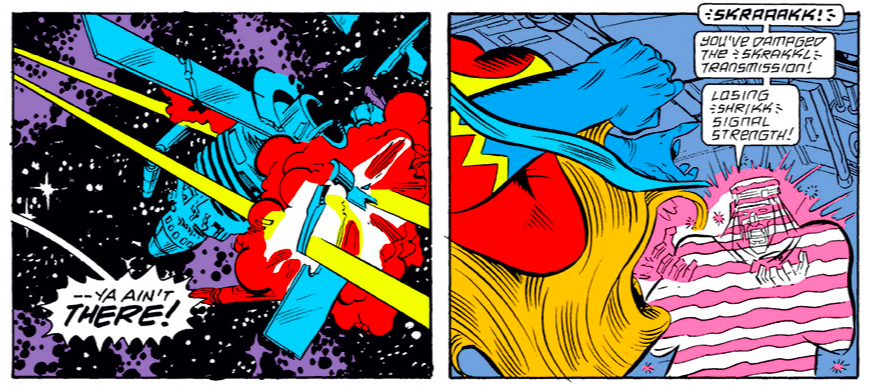
1:52:48-2:09:02: Aware of just how long this episode is running, we run through a recap of Fantastic Four #309 and get to #310, where we can’t help ourselves talking about new series artist Keith Pollard — or, if you’re Jeff, Ron Wilson — and the dynamism he brings to what should be a fairly lackluster conclusion to the Fasaud three-parter, despite the sly political commentary just under the surface. At least we can take some joy from the awkward date between Johnny, Alicia and Crystal. Oh, and by the end of #310, the team has an extra Thing to deal with…
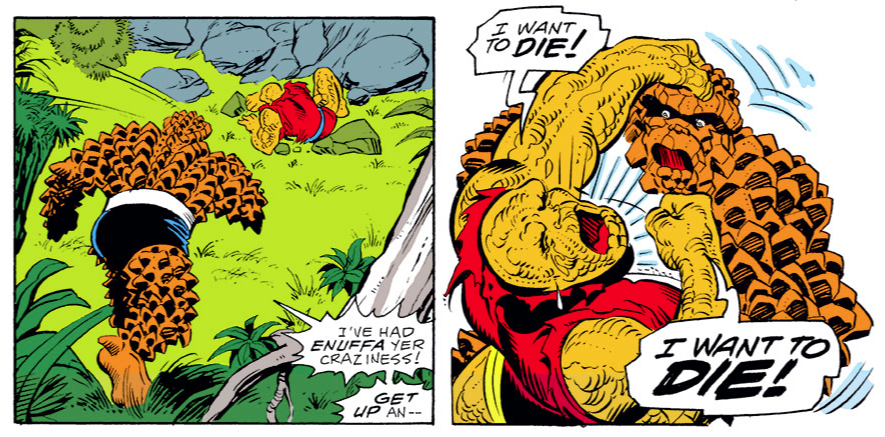
2:09:03-2:21:30: As if this run hasn’t been weirdly off-kilter before this point, FF #311 — which is genuinely titled, “I Want To Die!” — ends up being far too dark for Jeff, and it’s surprisingly not because of panels like the above. As we discuss a suicidal Sharon, an unthinking Ben and the respect between monarchs and quite how dark is appropriately dark for this particular superhero comic, we find allusions to Jonathan Hickman and my being far more forgiving to Steve Englehart’s intentions than he perhaps deserves. Maybe that’s how I feel with the darkness.

2:21:31-2:33:17: How to come back from what is probably the most disturbing comics in this entire series? Well, to judge by Fantastic Four #312, the trick is to bring in X-Factor for a guest shot. Sales figures and my childlike sense of joy and wonder fall under the verbal microscope as we witness what appears to be the end of all the neuroses that have been driving the series for the past few issues. Who’d’ve thought that an X-Factor cameo would bring an end to the worst of the soap opera…?
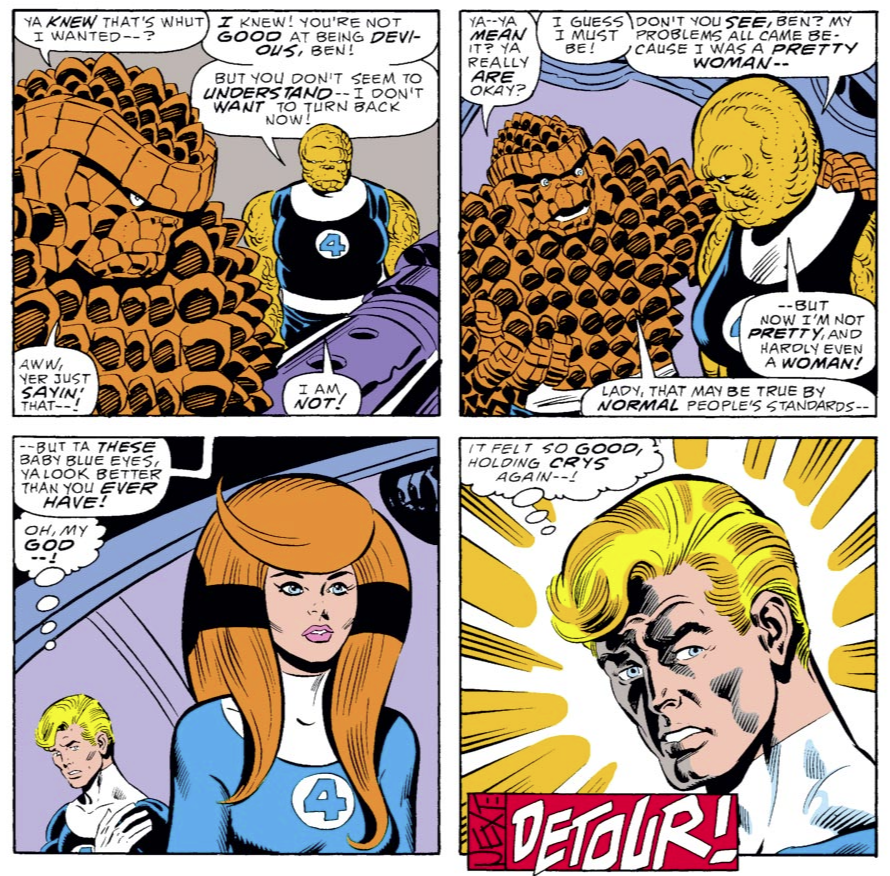
2:33:18-2:44:30: If FF #313 feels like a letdown — and it does — that might simply be because it’s less fueled by emotional dysfunction or bad decision-making than it is good old-fashioned plot mechanics (and, as Jeff points out, a retcon about FF #296, but that’s nothing new). The Mole Man makes a very short return, but to be honest, I’m more concerned about off-model Ben Grimm and Johnny being unimpressed by Ben’s chat-up lines.
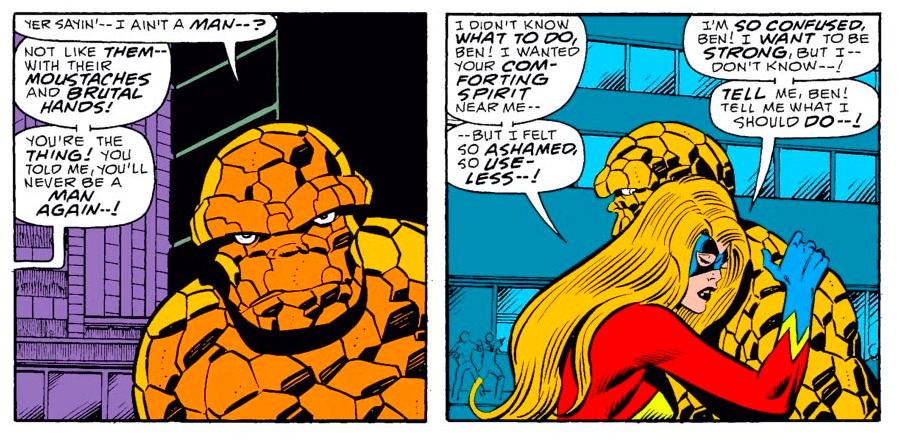
2:44:31-end: We wind down to the end of the episode by talking about the ways in which the series has changed in such a short period of issues, and looking forward to what lies ahead, including an appearance by none other than the Beyonder. (We’ll be doing Fantastic Four #s 314-324 next time, for those looking by the numbers.) While you’re waiting for that to happen, feel free to check out our Twitter, Tumblr and Patreon. As always, thanks for being patient with incredibly long episodes, and also delayed show notes. We’re doing it all out of love, even if it doesn’t feel like it at the time, I promise…!


And for those following along at home… http://theworkingdraft.com/media/podcasts2/BaxterBuildingEp34.mp3
I’m pretty sure I’ve plugged him before on this site, but Jose Alaniz’s book “Death, Disability, and the Superhero” has about a dozen pages spent analyzing She-Thing, particularly contextualizing it with contemporary legal cases involving assisted suicide and the disabled. (If you thought these issues were dark before…) Here’s an excerpt where he refers to talking directly with Englehart about her:
“Ventura’s immediate, suicidal response to her transformation by cosmic rays into a female version of the Thing, as noted, evokes critical issues pertaining to gender, disability, sexuality, body image, and morality. At the time of the character’s debut, She-Thing challenged conventional notions of beauty and femininity, in the process destablizing them–and proved a deeply divisive figure for fans and even for Marvel’s editorship. Englehart, in fact, told me considered She-Thing the most polarizing character he ever created, and a major factor in his removal from the series.”
*”told me he considered” Whoops.
I cannot imagine how long each individual podcast would take, but what about you two tackling all of Steve Englehart’s books in chronological order?
Hard to believe that when we saw Englehart’s first Fantastic Four book, cover-dated July 1987, he also had out on the stands his first Silver Surfer issue with Marshall Rogers. And at the same time he was continuing his stories on West Coast Avengers and over at DC still turning out Green Lantern Corps and gearing up for Millennium and New Guardians.
When Quicksilver kidnapped Alicia in the FF, over in WCA they were in the tail end of their Lost in Space-Time adventure with the HawkeyeMockingbird/Night Rider mess in the past and Hank Pym and Espirita in the present. So, it was only a few months before Sharon expressed her desire to die that we saw Hank Pym pull a pistol on himself. And Arisia of the Green Lantern Corps was meeting Star Sapphire. Agh!
I am not sure what to make of all that. Or what he was trying to say. These sometimes over the top horrific soap operatics may have been just his attempt to bring in more-adult themes to Comics Code Authority books, the kind of stories he was able to explore in Scorpio Rose and Coyote just a couple of years before.
Although a lot of these attempts have not aged well, I did find myself more troubled than cringing at the plight of Sharon. It may be partly because of the current news, with the metoo tags all around. Her storyline definitely hit me differently this time around than when I read them 30 years ago.
Outside of her “Englehartian” rising and advancing of spirit, her character always seemed to be important to his FF in that she was a brand new set of eyes and through her experience the adventures could look fresh — even when they involved old hats like Doctor Doom and the Mole Man and Diablo.
Anyhow, don’t think I’ve read these stories in twenty or so years. Looking forward to the re-reads and glad to have you both along for the ride this time.
Can I second the motion? The more you guys cover Englehart, the happier I am.
Even at age 10, I thought it was odd, or kind of a dodge, for Sharon to eventually be so happy with being a She-thing because of her trauma, that she felt so uncomfortable in her own skin that the solution was to become a monster. I wasn’t sure about the message that was trying to send. Or what message, if at all, it was.
Can I third the motion? This was the most entertaining episode of Baxter Building so far, and when you are done with Fantastic Four an Englehart PodCast from you would be a treat. He really seems to bring out the best in you both!
A MacMillan/Lester readthrough of Englehart’s Green Lantern would be AMAZING.
So about Fasaud….
If you take him as strictly a stand-in for a member of the House of Saud of Saudi Arabia and his country as strictly a Saudi Arabia stand-in, then, uh, it’s less racist than a realistic depiction of how awful Saudi Arabia is. Because they explicitly are still an absolute monarchy ruled by a noble family that literally branded the House of Saud’s name on the country. They do control women that way. They are in bed with the US government who overlooks all the evil shit and terrorism funding they do because we want an ally in the Middle East.
Is FaSaud actually that racist?
Yeah, I’m not really down with the House of Saud, but… considering he is pretty much the only representation of an Arab character (with the exception of the other members of Aqirian government who are in agreement with him) in the book, and probably the Marvel Universe at that point (the occasional Contest of Champions-created hero aside)? It’s pretty darn racist.
How many positive depictions of Arabs are preferred before Marvel writers are permitted to criticize a hateful, racist and misogynist regime?
Having previously written a paper on depictions of Muslims in Marvel Comics you’re correct that the number is low. But does that cast shade on criticism, especially when said criticism is intertwined with a comment on the dubious politics of the writer’s own country?
Annual 21 is the same month as issue 318, will you be covering it?
To be on the safe side, let’s say yes? (I haven’t run it by Graeme but knowing his completist heart, I think it very likely he’ll be down with it.)
Thanks for pointing it out!
Another tiptop episode, and splendid notes, but a wee query. A couple of times Jeff mentioned double puns. Now, I see ‘Marvel Rage’ as a play on Marvel Age, and get ‘Fasaud’ for ‘facade’, but where are the secondary puns?
Windsor Rains, that’d be a great pun name for Weather Wizard!
Oh, I was probably unclear (as always). The FF Annual we cover is called, “Double Double!” and each chapter heading has a different term (“Double Dealing,” “Double Down,” “Double Play”). Some of them are actually double puns, in the sense the “double” in each refers to the two Dooms running around throughout the issue, but as I recall, Doom does actually double deal (cheat) in that chapter, double down in the next. So they actually are double puns in some cases, despite being “double” puns in all of them?
Oh the joyful confusion! Ta Jeff.
Great discussion as always, guys, especially since I had recently re-read these issues myself and had been…more than a little squeamish about Sharon’s characterization and motivation.
BUT! I have to take umbrage at one assertion. You guys talked about how Gruenwald had Ms. Marvel assaulted while she was a guest character etc and that isn’t exactly true. I re-read Cap 331 as well (because I’m a completist idiot!) and while she’s DEFINITELY been assaulted and is suffering from some kind of PTSD, she does not appear to have the same aversion to men that pops up as soon as Englehart gets her in FF. It can be argued that Englehart just built up from what Gruenwald has implied (and there’s certainly enough blanks left in her narrative to add whatever Englehart might want), but I think the extrapolation might have been a…bit…more excessive than originally envisaged.
Admittedly it’s not like any of us can ever be sure, but Gruenwald’s plot/dialogue seem to suggest she’s suffered from abuse and is in a horrifying place, but is not necessarily a victim of sexual assault. Minor nitpick, I know, but I almost think this makes her storyline much worse because Englehart’s slight retcon/story exists entirely to, in Grimm’s parlance, make her “nuts” and give Thing a savior role to, possibly (?), offset his jerkiness to Alicia and Johnny.
Just my $0.02 of course.
(also, I would have KILLED for the version of Englehart’s FF with Doom as the fourth member. That sounds FANTASTIC!)
Ha, I emailed Graeme & Jeff about the exact same thing. Here’s the Cap page in question in case anyone’s curious:
https://waitwhatpodcast.com/wp-content/uploads/2017/10/MsMarvel.jpg
(Can we embed images here? I have no idea! Let’s see.)
No. No we cannot.
The only one of these issues I read was the X-Factor tie-in issue, since it was reprinted in a Fall of the Mutants collection. I remember being exceedingly irritating that Hank’s (temporary) intelligence loss was used as nothing but motivation fodder for Sharon, because people with intellectual disabilities almost never get their own stories in fiction. It’s always just to make other people look better or worse based on how they treat them.
But then, there’s no intellectual disability in reality that’s analogous to that stupid fucking “the power is drained from the mind!” thing Hank was saddled with as a convoluted path to get him back to his blue-furred self.
That’s ultimately where Hank’s plot led, but I think the Simonsons introduced it primarily to service Fall of the Mutants as part of the tearing down of X-Factor: Warren turning evil, Bobby losing control of his powers, Hank losing his intellect, Scott & Jean barely able to speak to each other.
One of my favourite moments in all of the Simonsons’ X-Factor remains Scott & Jean resolving their tension and working together to get the team back on its feet – that moment where they realize their emotional problems pale in comparison to what everyone else is dealing with and the two of them need to share leadership.
(it might be more accurate to say Infectia was created as a means of getting Beast back to his blue fur)
And as you well know, Neil, disabilities in super hero comics are almost always going to be portrayed as a challenge to be overcome – not a shift in status quo (not even a high-profile case like Barbara Gordon proved permanent). If that fan theory of Reed Richards being autistic became text it would likely be done in order to set up a plot where he would stop being autistic.
One of the awkward aspects of Ben’s new design is that his pants appear to have stopped the cone growths in a way that suggests it was not thought through. Despite this, one of the revelations of ‘Baxter Building’ is how much I like Keith Pollard’s comics, My teenage self had dismissed him as another Kirby/Buscema knock off, but it’s a pleasure to realise that below that surface he’s putting those panels and pages together very skilfully.